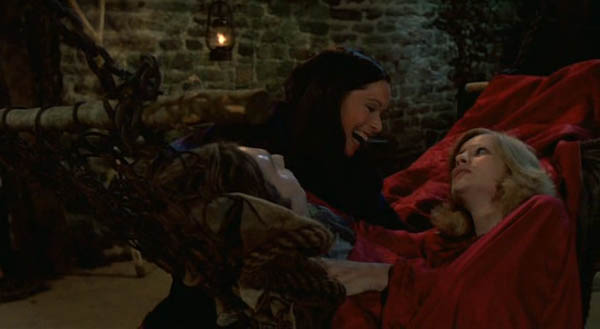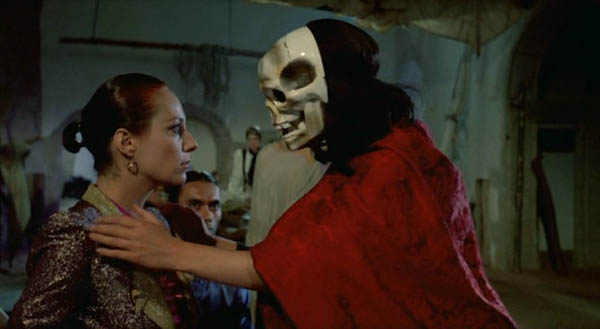This review of Jacques Rivette’s weirdest film, from the Winter 1976/77 issue of Sight and Sound, is one of the few pieces of my significant writing on Rivette from this period that hasn’t already been reproduced either on the excellent web site devoted to Rivette, “Order of the Exile,” or on this web site (e.g., my essay for Film Comment about Duelle). Having spent five very memorable days during the summer of 1974 watching the shooting of Noroît, in and around a 12th century fortress on the Brittany coast (see “Les Filles du Feu: Rivette x 4″, an article I wrote with Gilbert Adair and the late Michael Graham, reproduced on “Order of the Exile”), this was a film that I found in some ways even more compelling as a project than as a realized work.—J.R.
Noroît
If each new Rivette film marks a decisive break as much as a discernible development, Part III in the projected Scènes de la Vie Parallèle — the second film made in the tetralogy — reinforces this principle with a vengeance. Receiving its world premiere at the London [Film] Festival, immediately after a screening of Duelle (Part II of the cycle, discussed in my Edinburgh article elsewhere in this issue), Noroît has already occasioned the sort of extreme realignments provoked by Spectre after L’amour fou, or by Duelle after Céline et julie vont en bateau. Rather like the pitiless Chuck-a-Luck in Rancho Notorious, enlisting new players and expelling old ones with every spin of the wheel, Rivette’s precarious game has always been predicated on enormous risks; but unlike that vertical roulette board, it is not necessarily played to be won. Demonstrating this fact with shocking clarity, Noroît enters a treacherous, kaleidoscopic no-man’s-land where the very notion of judgment in any ordinary sense — the director’s or ours — largely seems beside the point. The old-fashioned term for this realm is “experiment”.
What are some of its ingredients? (1) A pirate tale fashioned out of diverse parts of Moonfleet, House of Bamboo, various samurai sagas, and Tourneur’s The Revenger’s Tragedy, set on “A small island on the Atlantic, off the coast of a larger one” in no locatable period, and structured, like Duelle, on the successive elimination of every character, developing towards a confrontation between a moon ghost and a sun fairy. (2) A few English lines of Tourneur, violently wrenched out of context and recited by the avenging ghost Morag (Geraldine Chaplin) and/or her accomplice Erika (Kika Markham), as incantation, simple quotation, or in a hammy style suggesting Land of the Pharaohs — playing, like the French dialogue, on a variety of uncanny emotional registers, which, along with facial and body movements, range from the nightmarish to the parodic. (3) Music improvised by a visible trio who contrive to combine “modern” and “primitive” elements on an assortment of instruments, with a use of direct sound throughout offering another broad palette of possibilities, from the wind and sea to the squeaks and swishes of the lavender leather pants suit worn by Giulia (Bernadette Lafont), sun fairy and head of the pirate clan. (4) A systematic development towards ritual, fantasy, dance, gibberish, and total abstraction of the narrative, with camera distance and darkness — coupled with facial masks, red filters, and silent 16 mm black-and-white footage in the aggressive last sequence – periodically making it difficult or impossible to identify certain characters, transforming the coordinates into those of pure spectacle.
Noroît contains the most beautiful images and sounds of any Rivette film, and the fewest indications of what a spectator is meant to do with them, apart from look and listen. While the plot is generally easier to follow than in Duelle, the shifting levels of mood and tone produce a sustained uncertainty of response –- reaching an apotheosis in the mutual stabbing and subsequent laughter of Giulia and Morag in the final shot, which perfectly encapsulate the film’s clashes and contradictions. On the level of identification, a subjective pan from beach to fortress in the first sequence initially designates Morag as the viewer’s reference point. But in a film that is executed according to principles of discontinuity, plot itself -– by sheer virtue of its continuity –- eventually becomes the least relevant aspect of its experience. And by the time Morag is back on the beach near the film’s end, and a comparable pan across the Atlantic is abruptly introduced in the middle of another camera movement following Erika round a room in the fortress, the subjective reference has significantly been raised -– or reduced -– to the level of abstraction, like a phrase in a foreign tongue.
A great many of the preoccupations can be traced back to Rivette’s seminal review of Lang’s Beyond a Reasonable Doubt in Cahiers du Cinéma No. 17, nineteen years ago. There one finds the notion of a “totally closed universe” (all the more paradoxical in Noroît, which abounds in spectacular vistas and spacious interiors), where a director who “always looks for the truth beyond the probable…looks for it here by entering the improbable.” Equally present is an aesthetics of self-destruction, whereby each scene is restricted to a procession of “pure moments” in which anything that might fix them to reality is “reduced to the condition of pure spatio-temporal reference, without embodiment” and “the characters have lost all individual value, are no more than human concepts,” defined only by what they say or do – the strictly material space and existential duration in which an actor moves.
These are of course the conditions of the theater rehearsal, examined at length in Paris Nous Appartient, L’Amour Fou, and Spectre, where the actual end-point of “performance” is never reached. The radical departure of Noroît is to resume that inquiry (with improvised music assuming the role of the relatively “fixed” percussion in L’Amour Fou and Spectre, thereby increasing the sense of perpetual try-out) without the narrative-illusionist pretext of the rehearsal to “place” it, apart from a few perverse instances that work more as displacements: Morag’s murder of Regina, which serves as “rehearsal” for its re-enactment by Erika and Morag before Giulia and her court; the rehearsed sword-fight between Ludovico (Larrio Eklson) and Jacob (Hubert Balsan), merging imperceptibly along with the music into a performance staged to confound Erika.
The most characteristic rhythmical pattern set by the delivery of lines and music, the movements of actors and camera, is one of stopping and starting, with odd-shaped pauses falling in between, while the tempi often tend to be either slower or faster than those favored in most Western dramaturgy, and somewhat closer to ones associated with dramatic and ceremonial forms found in Japan. Both these strategies converge in the climactic “masked ball,” lit by bonfires and punctuated by pageant-like repetitions –a choreography of confrontations and crossing vectors isolated in time and space, whose counterpart in Duelle is the central dance hall sequence, where the mirror breaks and the goddesses meet.
The madness and hysteria of the Tower of Babel is basic to every Rivette film; the maniacal giggling in Céline et Julie which irritates some spectators is merely one of the less sinister manifestations of it. Until now, each film has distanced this aspect by providing the audience with a phenomenological world to cling to; even Duelle, thanks to its cozy film noir references, nostalgic piano music, and Cocteau quotations, intermittently allows one to “enter” its reinvented Paris as a potential inhabitant. But the increasing move away from any semblance of “lived experience” in Noroît — making it a much more exciting and daring work in some respects -– ultimately implies little more than a “documentary” of a tournage and montage on the one hand, a capitulation to Babel itself on the other. Acknowledging the brilliance of William Lubtchansky’s photography, the precision of the frontal camera movements and long takes, the caustic bite of Eduardo de Gregorio’s dialogue, the dancer’s grace of Ekson, the chilling laughter of Lafont, the howls and mimes of Chaplin, the beauty of Markham, the savage power of the music –- and, above all, the continual shifting of gears, placing one at a tangent to all these elements as they struggle independently or collectively towards representation -– one is nevertheless obliged to ask just where Rivette’s experimentation is headed.
JONATHAN ROSENBAUM








